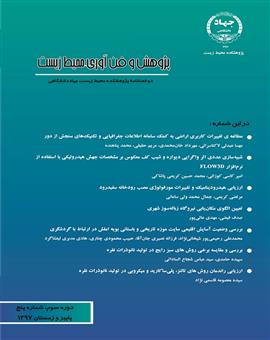مطالعه ی تغییرات کاربری اراضی به کمک سامانه اطلاعات جغرافیایی و تکنیکهای سنجش از دور
محورهای موضوعی : سنجش از دور و جغرافیای زیستی
مهرداد خانمحمدی
1
,
مریم حقیقی خمامی
2
![]() ,
محمد پناهنده
3
,
مهسا عبدلی لاکتاسرائی
4
*
,
محمد پناهنده
3
,
مهسا عبدلی لاکتاسرائی
4
*
1 - دانشگاه گیلان
2 - عضو هیات علمی
3 - عضو هیات علمی جهاددانشگاهی
4 - دانشگاه گیلان
کلید واژه: سنجش از دورپارک ملی بوجاقآشکارسازی تغییراتکاربری و پوشش اراضیماهواره لندست,
چکیده مقاله :
بدون تردید مناطق حفاظت شده، پارک های ملی و بهطور کلی زیستگاههای زیست کره، میراثهای با ارزش طبیعی هر کشور محسوب میشوند. از اینرو اطلاع از تغییرات آنها نقش اساسی در کیفیت مدیریت این مناطق دارد. سنجش از دور از جمله تکنولوژیهای برتر و کارآمد در مدیریت منابع و بررسی تغییرات زیست محیطی است. هدف از انجام این تحقیق آشکارسازی تغییرات کاربری/پوشش اراضی پارک ملی بوجاق استان گیلان در طی سالهای 2000 تا 2017 میباشد. بدین منظور تصاویر سنجنده +ETM ماهواره لندست 7 در سال 2000 و سنجنده OLI ماهواره لندست 8 در سال 2017 اخد گردید. بعد از اعمال پیش پردازشهای لازم روی تصاویر، نقاط تعلیمی برای هر یک از طبقات کاربری به تعداد کافی و با پردازش مناسب انتخاب شد و با بهرهگیری از روش طبقهبندی نظارت شده با الگوریتم حداکثر احتمال نقشه کاربری/پوشش اراضی منطقه تهیه شد. با استفاده از آزمون صحت کلی و آماره کاپا صحت نقشههای تولیدی با قابلیت متوسط تعیین گردید. نتایج تحقیق نشان داد مساحت بخش دریایی، پوشش علفی و پیکره آبی کاهش داشتهاند و مساحت کاربریهای کشاورزی، باتلاقی، انسان ساخت، درختی و بدون پوشش افزایش یافتهاند.
Indeed, protected areas, national parks and biosphere reserves in general, are the natural heritage of each country. Therefore, knowledge of their changes plays an essential role in management of these areas. Remote sensing is one of the most advanced and effective technology for monitoring environmental changes and resource management. The purpose of this research is to detect the land use /cover changes in Bojagh National Park in Guilan province during 2000-2017. For this purpose, the images of ETM+ sensor from the landsat 7 were taken in the year 2000 and the images of OLI sensor from the landsat 8 were taken in the year 2017. After applying the necessary preprocessing on the images, the training points were selected for each user class in sufficient number and with appropriate processing then, the land use / cover map was produced using the supervised classification method with maximum likelihood algorithm. Using the Overall accuracy test and Kappa coefficients, accuracy of the produced maps was determined. The results of the study indicated that the areas of the sea, grassland and the areas of the waterbody parts has decreased and the areas of the agricultural, marshland, man-made, woody and bare lands users show an increase during the study period.
1. Yaghobzadeh, M. and Akbarpour, A., 2011, The effect of satellite image classification algorithm based on curve number runoff and maximum flood discharge using GIS and RS, Geography and Development 9 (22):5-22.
2. Reger, B., Otte, A. & Waldhardt, R., 2007, Identifying Patterns of Land-Cover Change and their physical Attributes in a Marginal European Landscape, Landscape and Urban Planning, Vol. 81, No. 1-2, PP. 104-113.
3. Shalaby, A. & Tateishi, R., 2007, Remote Sensing and GIS for Mapping and Monitoring Land Cover and Land-Use Changes in the Northwestern Coastal Zone of Egypt, Applied Geography, Vol. 27, No. 1, PP. 28-41.
4. Sonmez, N.K. & Sari, M., 2007, Monitoring Land Use Change in the West Mediterranean Region of Turkey: A Case Study on Antalya-Turkey Coast, Fresenius Environmental Bulletin, Vol. 16, No. 1A, PP. 1325-1330.
5. Serra, P., Pons, X. & Sauri, D., 2008, Land Cover and Land-Use Change in a Mediterranean Landscape: A Spatial Analysis of Driving Forces Integrating Biophysical and Human Factors, Applied Geography, Vol. 28, No. 3, PP. 189-209.
6. Van, Oort, P.A.J., 2007, Interpreting the Change Detection Error Matrix, Remote Sensing of Environment, Vol. 108, No. 1, PP. 1-8.
7. Yuan, F., Bauer, M. E., Heinert, N. J., & Holden, G. R. (2005). Multi-level land cover mapping of the twin cities (Minnesota) metropolitan area with multi-seasonal landsat TM/ETM+ data. Geocarto International, 20(2), 5-13.
8. Jenson, J.R., 2007. Remote Sensing of the Environment: An Earth Resource Perspective, Pearson Prentice Hall, p: 297.
9. Jenson, J. R., 2005. Introductory Digital Image Pro-cessing: A Remote Perspectire, 3rd Edition, Up-per Saddle River. Prentice-Hall, 526.
10. Sabzeghabaei, GH., Dashti, S., Raz, S., & Yosefi Khanghah, SH. (2017). Study of Land Use Change Using Geographic Information Systems and Remote Sensing Techniques (Case Study: Andimeshk Township). Geography and development, 15(46), 35-42. (IN Persian).
11. Alishah, Barat, F., Arzani, H., Hoseini, S.Z., Babayi Kafaei, S & MirAkhlo, KH. (2011). Investigation of IRS-LissIII Satellite Data Capability in Differentiating Rangeland Landes from Other Uses (Case Study: Sorkh Abad Watershed-Mazandaran). Rangeland, 5(2), 154-147.(IN Persian).
12. Ayana, A.B., Kositsakulchai, E., 2012. Land Use Change Analysis Using Remote Sensing and Markov Modeling in Fincha Watershed, Ethiopia, Kasetsart J.(Nat.Sci.) 46:135-149.
13. Ha., M. Hong., J.2014. LAND USE CHANGEDETECTION IN THE NORTH CENTRAL REGION USING REMOTE SENSING DATA. International Journal of Engineering and Applied Sciences. June 2014. Vol. 5. No. 01.pp:20-29.
14. Fan, F. Wang, Q. Wang, Y. 2007. Land use and land cover change in Guangzhou, China, from 1998 to 2003, based on Landsat TM/ETM+ imagery. Sensors. 7: 1323-1342.
15. Stehman, S.V. (2004): A critical evaluation of the normalized error matrix in map accuracy assessment/ Photogrammetric Engineering and Remote Sensing, 70, 743-751.
16. Melesse, A. M. and Jordan. J. D, (2003): Spatially distributed watershed mapping and modeling, Thermal maps and vegetation Indices to enhance land cover and surface microclimate mapping; Part I. Journal of spatial hydrology, 3, 325-338.

